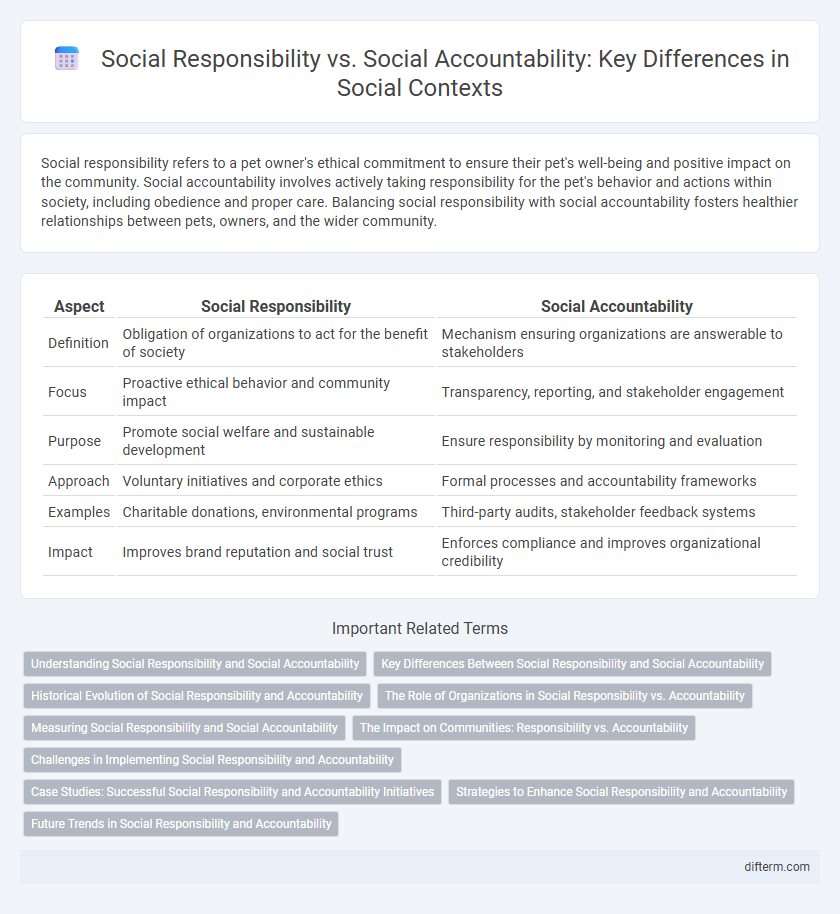Social responsibility refers to a pet owner's ethical commitment to ensure their pet's well-being and positive impact on the community. Social accountability involves actively taking responsibility for the pet's behavior and actions within society, including obedience and proper care. Balancing social responsibility with social accountability fosters healthier relationships between pets, owners, and the wider community.
Table of Comparison
| Aspect | Social Responsibility | Social Accountability |
|---|---|---|
| Definition | Obligation of organizations to act for the benefit of society | Mechanism ensuring organizations are answerable to stakeholders |
| Focus | Proactive ethical behavior and community impact | Transparency, reporting, and stakeholder engagement |
| Purpose | Promote social welfare and sustainable development | Ensure responsibility by monitoring and evaluation |
| Approach | Voluntary initiatives and corporate ethics | Formal processes and accountability frameworks |
| Examples | Charitable donations, environmental programs | Third-party audits, stakeholder feedback systems |
| Impact | Improves brand reputation and social trust | Enforces compliance and improves organizational credibility |
Understanding Social Responsibility and Social Accountability
Social responsibility involves organizations voluntarily committing to ethical practices and contributing positively to society beyond legal requirements, while social accountability demands transparency and answerability to stakeholders regarding social impact. Understanding social responsibility emphasizes proactive efforts in sustainability and community welfare, whereas social accountability focuses on mechanisms like reporting and stakeholder engagement to ensure these commitments are fulfilled. Both concepts are essential for building trust, fostering ethical behavior, and promoting sustainable development in business and governance.
Key Differences Between Social Responsibility and Social Accountability
Social responsibility refers to an organization's voluntary commitment to ethical practices and positive social impact, often guided by internal values and stakeholder expectations. In contrast, social accountability involves external mechanisms, including transparency, reporting, and stakeholder engagement, to ensure organizations are held answerable for their social and environmental performance. Key differences lie in the proactive nature of social responsibility versus the reactive, oversight-based approach of social accountability, emphasizing compliance versus commitment.
Historical Evolution of Social Responsibility and Accountability
The historical evolution of social responsibility traces back to early philanthropic efforts in the 19th century, evolving into corporate social responsibility (CSR) frameworks by the mid-20th century, emphasizing ethical business practices and community engagement. Social accountability emerged later, rooted in transparency and stakeholder involvement, driven by global movements demanding organizations be answerable for their social and environmental impacts. This shift reflects a growing expectation for organizations to not only act responsibly but also to report and be held accountable for their social performance publicly.
The Role of Organizations in Social Responsibility vs. Accountability
Organizations play a critical role in social responsibility by proactively integrating ethical practices, community engagement, and sustainable development goals into their core operations. Social accountability demands transparent reporting and responsiveness to stakeholders, ensuring that organizational actions align with societal expectations and regulatory standards. Effective organizations balance both responsibilities by fostering trust through ethical conduct while being held accountable for their social and environmental impact.
Measuring Social Responsibility and Social Accountability
Measuring social responsibility involves evaluating a company's commitment to ethical practices, community impact, and sustainable development through metrics like environmental impact assessments, employee welfare programs, and stakeholder engagement. Social accountability is measured by assessing transparency, compliance with social standards, and responsiveness to social issues, often using frameworks such as SA8000 or the Global Reporting Initiative (GRI). Effective measurement requires integrating qualitative and quantitative data to provide a comprehensive overview of organizational social performance.
The Impact on Communities: Responsibility vs. Accountability
Social responsibility emphasizes proactive efforts by individuals or organizations to positively contribute to community well-being, fostering sustainable development and social equity. Social accountability focuses on mechanisms through which communities hold institutions or leaders answerable for their actions, ensuring transparency and responsiveness. The combined impact influences trust, empowerment, and systemic change within communities, driving collective progress.
Challenges in Implementing Social Responsibility and Accountability
Implementing social responsibility often encounters challenges such as unclear stakeholder expectations, limited resources, and inconsistent policy enforcement. Social accountability requires transparent mechanisms and active community engagement, which can be hindered by lack of trust and insufficient data collection. Addressing these obstacles demands integrated strategies that align organizational goals with measurable social outcomes and ethical governance.
Case Studies: Successful Social Responsibility and Accountability Initiatives
Case studies illustrating successful social responsibility and accountability initiatives reveal companies implementing transparent reporting systems and engaging local communities to address environmental and social challenges. For example, Patagonia's commitment to sustainable sourcing and Toms' one-for-one giving model demonstrate measurable social impacts through ethical business practices. These initiatives emphasize accountability by setting clear goals, monitoring progress, and publicly sharing outcomes to foster trust and long-term positive change.
Strategies to Enhance Social Responsibility and Accountability
Implementing transparent communication channels and robust stakeholder engagement strategies significantly enhances social responsibility by fostering trust and collaboration. Establishing clear metrics and regular reporting frameworks ensures social accountability, enabling organizations to measure and demonstrate their impact effectively. Integrating ethical decision-making processes with community-centric initiatives promotes sustainable development and strengthens corporate social performance.
Future Trends in Social Responsibility and Accountability
Future trends in social responsibility and social accountability emphasize enhanced transparency through blockchain technology and AI-driven data analysis, enabling organizations to track and report their social impact with precision. Stakeholders increasingly demand real-time disclosure of environmental, social, and governance (ESG) metrics, driving companies to adopt integrated reporting frameworks like the Global Reporting Initiative (GRI) and the Sustainability Accounting Standards Board (SASB). Corporate social responsibility (CSR) is evolving towards proactive stakeholder engagement, where social media platforms amplify accountability and foster community-driven monitoring of corporate behavior.
social responsibility vs social accountability Infographic

 difterm.com
difterm.com